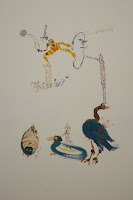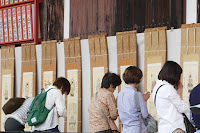Today, we took the train to Karasuma-Oike station and discovered some cute mural painted stairs and a rather wonderful exhibit of cardboard animals and stuffed animals. I love the little surprises you get in Kyoto.
Then we emerged onto the Horikawa-Oike street, where we joined the crowds waiting by the side of the road waiting for the Jidai-Matsuri Festival. This festival is annually held on the 22nd October, and stages a costume procession representing the people of each era in the history of Kyoto. It is a truly amazing spectacle since about 2000 performers (ranging from old men and women to quite young children) slowly parade from the Imperial Palace to the Heian-Jingu shrine dressed in traditional clothes, which demonstrate the strata of society that they are representing.
There are also carriages,
bullocks,
horses,
bands,
and floats.
It is quite an awe inspiring procession but terribly tiring unless you manage to bring a seat as it goes on for 2 1/2 hours. We didn't last till the end because we were starving at about three o'clock, so finally succumbed for the need to eat, leaving the lovely ladies that we had been exchanging cultural notes with to watch the whole show.
We have discovered in Kyoto that often the best shops and restaurants are to be found hidden upstairs, unobtrusively, in some building. We saw a food sign at the front door of the Duce Mix building, and had a lovely lunch in a little restaurant called the Collobo. We had noticed , when climbing the stairs, that the stairwells were painted with quite witty little drawings and paintings.
We discovered that the whole building was inhabited by shops displaying art and handcrafts and clothing by various artisans. Our favourites were Atelier Turr, which had amazing jewellery , hats, ceramics and gifts, Phooka, which stocked Scandinavian gifts and Idola, which stocked buttons, beads, fancy pins etc. We would like to explore some of the others, like the knitting shop Yau, on another trip.
We next visited the Museum of Kyoto gift shops and discovered that the main one had an extensive range of handmade and commercial papers.
I have never seen such a vast collection. It had lovely souvenirs as well, but I was fixated on the papers. I need to come back with an empty suitcase. Attached to the museum are other shops displaying works of various local artists, and more souvenirs, but the most outstanding work was in the Arton art gallery, where the lovely Makiko Takashahi was displaying her humorous and very original glass works.
As usual, we got home very late, but we were very grateful for our last minute experiences.
Unfortunately, this is the end of our Japanese adventure. tomorrow, we travel all day to our airport hotel, then it is back home to reality. We fully intend to return again though. Japan is addictive!


































































